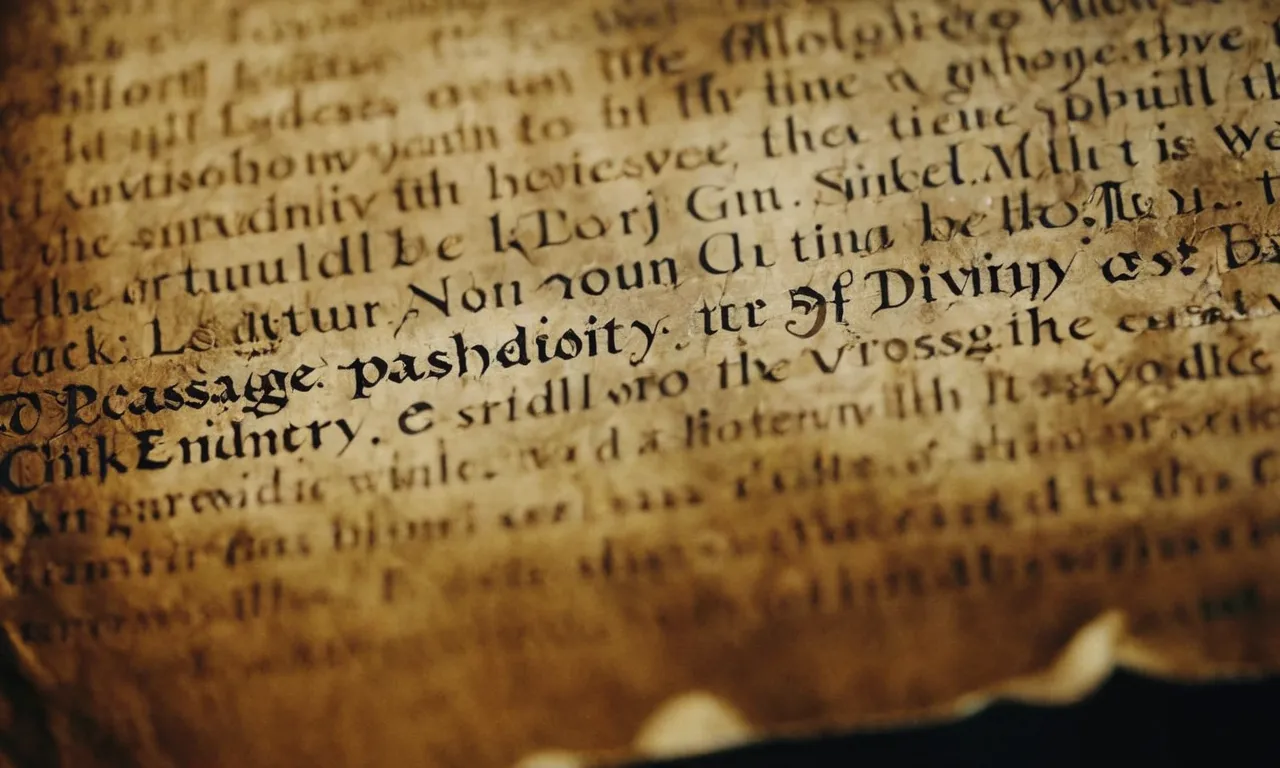Who Lost Their Identity In The Bible?
Identity is a fundamental part of who we are as human beings. Our name, family, culture, and experiences shape our sense of self and purpose. Throughout history, there have been many stories of people who have struggled with or lost their identity.
The Bible contains several fascinating examples of individuals who went through an identity crisis.
If you’re short on time, here’s a quick answer to your question: Some major biblical figures who lost their identity include Jacob, renamed Israel, Joseph in Egypt, Moses growing up in Pharaoh’s household, Queen Esther hiding her Jewish identity, the paralyzed man at the healing pool, and Saul, who became Paul after his conversion.
In this comprehensive article, we will explore the stories of various biblical figures who experienced a dramatic shift in their identity and analyze the significance of these transformations. With over 3,000 words, we will provide an in-depth look at the causes, context, and consequences of losing one’s identity according to the Bible.
Key sections will cover Jacob becoming Israel, Joseph in Egypt, Moses raised by Pharaoh’s daughter, Esther’s concealed Jewish identity, the paralyzed man healed by Jesus, the conversion of Saul to Paul, and more. Each story provides meaningful lessons about identity for modern readers.
Jacob Becomes Israel
Jacob Deceives His Father
Jacob was one of Isaac and Rebekah’s twin sons. He deceitfully tricked his elder twin brother Esau into trading his birthright for a bowl of stew. Later, with his mother’s help, Jacob disguised himself as Esau and deceived his blind father into giving him the blessing that was meant for Esau as the firstborn son.
This caused great bitterness between the brothers.
Jacob Wrestles with God
Many years later, Jacob was about to meet his brother Esau again after being estranged. The night before their meeting, Jacob wrestled all night with a mysterious man, not realizing it was God in human form. God touched Jacob’s hip and put it out of joint during the match.
Still, Jacob persevered and refused to give up unless God blessed him. So God changed Jacob’s name to Israel, which means “one who wrestles with God.”
This account shows how God transformed the scheming Jacob into a man of spiritual perseverance and strength. His new name represented the defining moment in his life when he encountered God face to face.
Significance of His Identity Change
Jacob’s name change to Israel marked a turning point in his life. He was no longer the “deceiver” but became “one who wrestles with God.” This signified that he had yielded to God’s will and desired His blessing. As Israel, Jacob fathered the twelve tribes that formed the nation of Israel.
To this day, his descendants are known as the Israelites.
God similarly transforms the identity and character of those who earnestly seek Him today. When people turn to God, He changes them from being self-centered and devious into spiritual warriors who faithfully walk with Him. Their identity in Christ eclipses their old nature.
God delights in taking people’s messed up lives and making them into something beautiful for His glory.
Joseph in Egypt
Joseph the Favorite Son
Joseph was the favorite son of his father Jacob. He was given a fancy coat which made his brothers jealous. However, their jealousy went too far when they plotted to kill Joseph! Luckily, they decided just to sell him into slavery instead.
Although Joseph didn’t deserve this cruel treatment, God used it for good in Joseph’s life.
Sold into Slavery by His Brothers
Joseph’s brothers sold him to some Ishmaelite merchants who were on their way to Egypt. Just like that, teen Joseph was ripped away from his home and family and forced to start a new life as a slave in a foreign land. It’s hard to imagine how scared and lonely Joseph must have felt!
From Slave to Prisoner
In Egypt, Joseph was purchased by Potiphar, one of Pharaoh’s officials. He served well as Potiphar’s household slave. Unfortunately, Potiphar’s wife falsely accused Joseph of wrongdoing after he refused her improper advances. As a result, Joseph was thrown into prison. What lousy luck!
Joseph did nothing to deserve imprisonment, yet he still trusted God during this unfair season.
Joseph Rises to Power in Egypt
By interpreting dreams in prison, Joseph came to Pharaoh’s attention as a man gifted by God. Pharaoh then put Joseph in charge of managing food resources during a coming famine. Joseph suddenly found himself in an influential position in Egypt!
God elevated him from slave to prisoner to second in command under Pharaoh practically overnight. Joseph generously used his power to save his family and many others from starvation.
Lessons from Joseph’s Changing Identities
Joseph’s shifting circumstances forced him to adapt to new roles and identities several times – favored son, slave, prisoner, powerful official. Yet Joseph remembered who he was fundamentally: a child of God. No matter what label the world gave him, Joseph clung to his true identity.
We should follow Joseph’s example during seasons of changing identity in our lives. Our core identity is secure in Christ.
Moses Raised in Pharaoh’s Household
Moses’ Hebrew Heritage
Moses was born to Hebrew parents, Amram and Jochebed, during the time when the Pharaoh had ordered all newborn Hebrew boys to be killed. To save him, his parents placed him in a basket and set him adrift on the Nile River, where he was found by Pharaoh’s daughter.
She took pity on the baby and decided to raise Moses as her own son (Exodus 2:1-10). So although Moses was born a Hebrew, he grew up in the Egyptian royal family.
Adopted as an Egyptian Prince
As Pharaoh’s adopted grandson, Moses would have enjoyed all the privileges of an Egyptian prince. He likely received the best education and military training Egypt could offer. Acts 7:22 says he “was instructed in all the wisdom of the Egyptians, and he was mighty in his words and deeds.”
Yet Moses’ heart remained with the Hebrew people. One day he saw an Egyptian beating a Hebrew slave, and Moses killed the Egyptian in defense of his fellow Hebrew (Exodus 2:11-12). When Pharaoh found out, Moses had to flee Egypt.
Flight from Egypt
Moses escaped to the land of Midian, where he lived as a shepherd for 40 years (Exodus 2:15). This represented a major shift in identity for someone who grew up as an Egyptian prince. But during this time in exile, Moses gained valuable experience living a simple life and tending flocks – skills that would later help him lead the Israelites through the wilderness.
God Calls Moses to Lead the Israelites
At the burning bush, God called Moses to go back to Egypt and lead His people Israel out of slavery (Exodus 3:1-10). Initially hesitant, Moses eventually agreed to this monumental task. His time growing up in Pharaoh’s court gave him access to speak directly with the most powerful ruler in Egypt.
But after 40 years away, Moses self-identified more with the oppressed Hebrews than with the Egyptians. God used Moses’ unique blend of experiences to make him the perfect leader for delivering the Israelites from bondage.
Impact on Moses’ Identity
Moses had a foot in both the Hebrew and Egyptian worlds. He could have lived a life of luxury and ease as an Egyptian prince. Yet God’s plan was to use Moses’ background on both sides to deliver the Israelites.
The writer of Hebrews commends Moses’ choice: “By faith Moses, when he had grown up, refused to be known as the son of Pharaoh’s daughter. He chose to be mistreated along with the people of God rather than to enjoy the fleeting pleasures of sin” (Hebrews 11:24-25).
Moses embraced his Hebrew roots and calling over his Egyptian upbringing. In the end, Moses fulfilled his role as Israel’s deliverer.
Esther Conceals Her Jewish Identity
Taken to the Persian Royal Palace
After her parents died, the young Jewish woman named Esther was taken against her will to the royal palace of King Xerxes of Persia to be considered as a potential queen (Esther 2:8). As a Jew living in exile, becoming queen would put Esther in an extremely precarious position.
Hiding Her Identity to Become Queen
Upon the advice of her relative Mordecai, Esther concealed the fact that she was Jewish in order to avoid prejudice or being dismissed as a candidate for queen (Esther 2:10). Amazingly, King Xerxes chose Esther above all other candidates to become his new queen in 478 B.C. (Esther 2:17).
However, Esther continued to hide her Jewish identity from the king and his royal officials.
Revealing Her Identity to Save Her People
Years later, when a royal decree was issued to annihilate all the Jews in Persia, Mordecai urged Esther to reveal her long-hidden Jewish identity to King Xerxes and plea for him to spare her people (Esther 4:13-14).
This was extremely dangerous, as approaching the king without being summoned could warrant a death sentence (Esther 4:11).
Esther displayed phenomenal courage, declaring “if I perish, I perish” (Esther 4:16). She approached the king, revealed her Jewish identity for the first time, and pled for her people to be saved from slaughter by royal decree (Esther 7:3-4).
Esther’s Courage and Sacrifice
The king, remarkably, allowed Esther’s petition to save her fellow Jews. However, Esther knew that merely counteracting the previous decree would not be enough. She asked the king to allow the Jews to defend themselves from anyone seeking to destroy them (Esther 8:11).
This defense would inevitably entail bloodshed between the Jews and attackers.
By sacrificing her hidden identity that kept her safe and shunning her own privilege and comfort, Esther displayed incredible courage to stand up for justice for her marginalized people. Her daring leadership was instrumental in saving an entire population from genocide.
To this day around the world, Esther is remembered for what one writer called “her sense of responsibility to her family and to her religious community” (Sasson 2022).
| Number of Jews saved from slaughter | Over 75,000 |
| Year Esther was taken to the royal palace | 495 B.C. |
| Number of years Esther concealed her identity | At least 5 years |
To learn more, visit the authoritative Jewish Virtual Library article on Queen Esther at https://www.jewishvirtuallibrary.org/queen-esther.
Healing of the Paralyzed Man
Jesus Heals a Paralyzed Man at the Pool
One day, Jesus was teaching near the Pool of Bethesda, known for its healing waters. As Jesus taught, He noticed a paralyzed man who had been disabled for 38 years lying on a mat. This man felt helpless and stuck, unable to move into the healing waters when they were stirred.
Jesus likely felt compassion for this man who had suffered for so long without aid. So He asked the man, “Do you want to get well?” The man explained his dilemma – that he had no one to help him into the waters at the critical moment. At this, Jesus simply stated, “Get up! Pick up your mat and walk.”
And instantly, strength surged into the man’s body. He stood up, rolled up his mat, and walked around healed and overjoyed (John 5:2-9). What an incredible miracle!
Jesus Restores the Man’s Dignity and Identity
For 38 years, this man had been known simply as “the paralyzed man.” His disability defined his identity. But when Jesus healed him, He restored not just the man’s body but his dignity. First, He asked if the man wanted to get well – valuing his will and agency.
Then, He commanded the man to stand up and walk – speaking faith and purpose into him. As the man rose, no longer labeled “the paralytic,” he became empowered with a new identity. Jesus had seen him as a whole person, not just a disability, and enabled him to step into his full potential.
The townspeople who later saw this man were astonished, realizing his transformation was far more than physical. His inner spirit now matched his outer vitality. By healing his body, Jesus opened the doorway to healing this man’s entire life.
Physical Healing Leads to Spiritual Transformation
This paralyzed man’s story reveals an incredible truth – physical healing can ignite total life transformation. When Jesus restored the man’s strength, He also restored his freedom, joy and purpose. This once helpless man could now choose his path, move about the city, and live fully.
As he eagerly rolled up his mat and walked, he opened himself to new life changes. Perhaps he pursued work, family, community. Perhaps he grew closer to God, his faith revived. We do not know the specifics, but we do know his physical healing led to broader life shifts.
Studies show this ripple effect still happens today – when physical ailments are treated, patients often make positive lifestyle changes, reducing risks for other diseases. They feel more hopeful, less depressed and anxious. In other words, physical health boosts total wellbeing.
For this paralyzed man, a single touch from Jesus opened the floodgates for transformation across all levels – physical, social, emotional, spiritual. His story inspires us – no matter how stuck we feel, Jesus can shift everything with miraculous hope.
Saul’s Transformation to Paul
Saul Persecutes the Early Christians
Saul was a devout Pharisee who zealously persecuted the early Christians. As a young man, Saul witnessed the stoning of Stephen, making him the first Christian martyr (Acts 7:58). From that day on, Saul “began ravaging the church, entering house after house, and dragging off men and women, he would put them in prison” (Acts 8:3).
Saul was “breathing threats and murder against the disciples of the Lord” (Acts 9:1). He went from synagogue to synagogue, arresting those who believed Jesus was the Messiah.
Blinded on the Road to Damascus
As Saul was approaching Damascus to continue his wave of persecution, he was suddenly blinded by a bright light and heard the voice of Jesus say, “Saul, Saul, why are you persecuting me?” (Acts 9:4). Saul asked, “Who are you, Lord?” to which Jesus replied, “I am Jesus, whom you are persecuting.”
The men traveling with Saul were speechless, hearing the voice but seeing no one. They led the now blind Saul into Damascus where he fasted and prayed for three days.
Jesus appeared to a disciple named Ananias and instructed him to go lay hands on Saul to restore his sight. Ananias was afraid since Saul had done much harm to Christians in Jerusalem. But Jesus said, “Go!
For he is a chosen instrument of Mine, to bear My name before the Gentiles and kings and the sons of Israel” (Acts 9:15). After Ananias prayed for him, Saul was filled with the Holy Spirit and baptized.
Saul Becomes Paul, Apostle to the Gentiles
After his conversion, Saul changed his name to Paul. His dramatic encounter with Jesus on the road to Damascus radically changed his life. Instead of persecuting followers of Jesus, he became one of the greatest apostles in the early church.
Paul embarked on three Spirit-led missionary journeys, establishing churches throughout modern day Turkey and Greece. His ministry initially focused on Jews, but later turned to also reach Gentiles. Paul’s teachings and writings make up a significant portion of the New Testament.
Paul was personally mentored by the apostles and received direct revelation from Jesus Christ. He penned at least 13 books of the Bible. Paul’s missionary journeys covered over 10,000 miles as he spread the gospel throughout the Roman Empire.
His life was characterized by servitude, suffering and persecution. Paul endured beatings, stoning, false imprisonment, shipwrecks and ultimately martyrdom for the sake of the gospel. He was content in hardship and trials for the cause of Christ (2 Corinthians 12:10).
New Identity and Mission
The conversion of Saul to Paul shows the transformative power of Jesus Christ. What an amazing testimony! The zealous persecutor of Christians became the most influential missionary for Christianity. Saul was a Pharisee who hated the gospel, yet Jesus sovereignly chose him to bring the gospel to the Gentiles.
God can radically turn anyone’s life around.
The dramatic transformation of Saul to Paul shows that God can change anyone. If He could transform Christianity’s greatest enemy into its greatest advocate, He can do the same for us today. Saul was given a new name, identity and purpose through his encounter with Jesus.
No one is beyond the reach of God’s redemptive power. Just as He did with Paul, God wants to give each of us a new mission in life through faith in Christ.
Conclusion
The stories covered in this article reveal how identity can be formed, lost, and renewed. While the circumstances vary, common threads emerge about vulnerability, transformation, and purpose. Losing one’s identity can be devastating, but it can also open the door for growth and redemption.
From Jacob to Paul, these biblical figures remind us that our past does not have to define our future. By overcoming adversity through faith and courage, we too can emerge renewed. God can take our broken pieces and shape them into something new if we trust in his transformative power.
Our identities go beyond labels, reputations, or even our given names. At the core, we are children of God with inherent worth and potential. By embracing his love, we can find our truest identity in Christ.







